Romania have failed to progress beyond the group stage of the UEFA European Championships since the year 2000 — the only edition of the tournament when they achieved this feat by making it as far as the quarter-finals.
They’ll hope to make it to the knockout phase again this year, with Belgium, Ukraine, and Slovakia standing between them and their long-awaited progression to the Euro knockouts.
This tactical analysis and team-focused scout report provides some analysis of Romania’s tactics under Edward Iordănescu, highlighting exactly what you can expect from them based on an impressive qualification campaign which saw them top their qualifying group with six wins and four draws.
Romania Starting XI
Romania have often lined up with either the 4-2-3-1 shape or the 4-1-4-1 out of possession.
The exact orientation of the midfield seems to sometimes be dependent on the opposition’s in-possession structure and the positioning of those midfielders due to the specific instructions placed upon the Romanian players.
However, to predict the starting XI for our tournament preview, we’ve decided to line Romania up in a 4-2-3-1 formation.
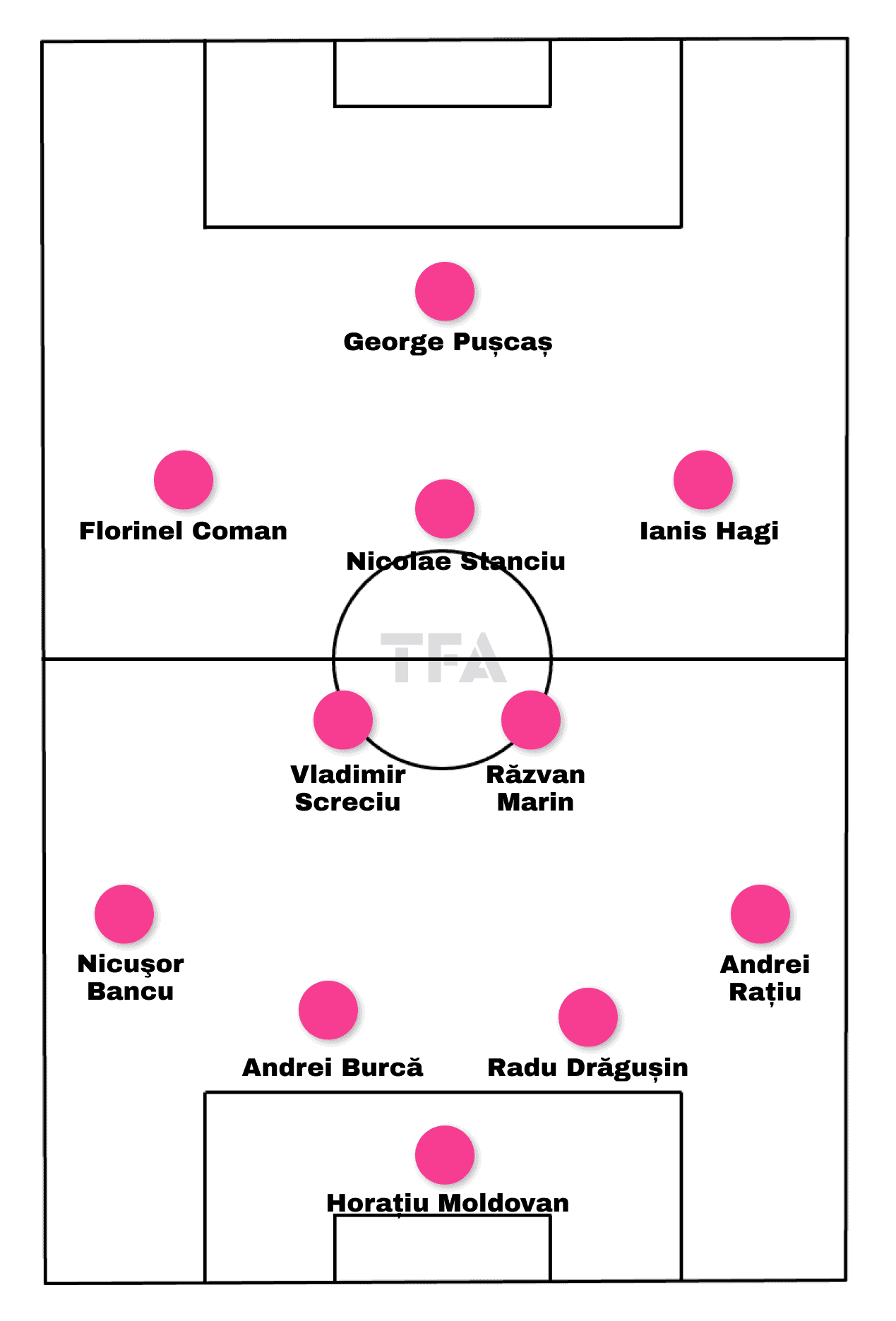
We have Horațiu Moldovan of La Liga giants Atlético Madrid starting between the sticks for Tricolorii, as he has often done in recent times, effectively claiming the Romania number one jersey for himself.
Ahead of him, we anticipate seeing another Spain-based player at right-back in the form of Rayo Vallecano’s Andrei Rațiu.
Alongside Rațiu, we’ve put Tottenham Hotspur’s Radu Drăgușin at right centre-back, who’ll likely play a key role for Romania in this tournament and may well be partnered by Al-Okhdood’s Andrei Burcă — dependent on fitness — in the heart of defence.
Lastly, we feel it’s a safe bet that we’ll find Nicușor Bancu at left-back, with the 31-year-old Universitatea Craiova man proving very difficult to displace in that particular position of late.
Vladimir Screciu partners Răzvan Marin in the deep central midfield positions for us, just behind captain Nicolae Stanciu, who will likely play a more attacking midfield role.
We foresee Ianis Hagi starting on the right, opposite Florinel Coman on the left, with George Pușcaș starting at centre-forward.
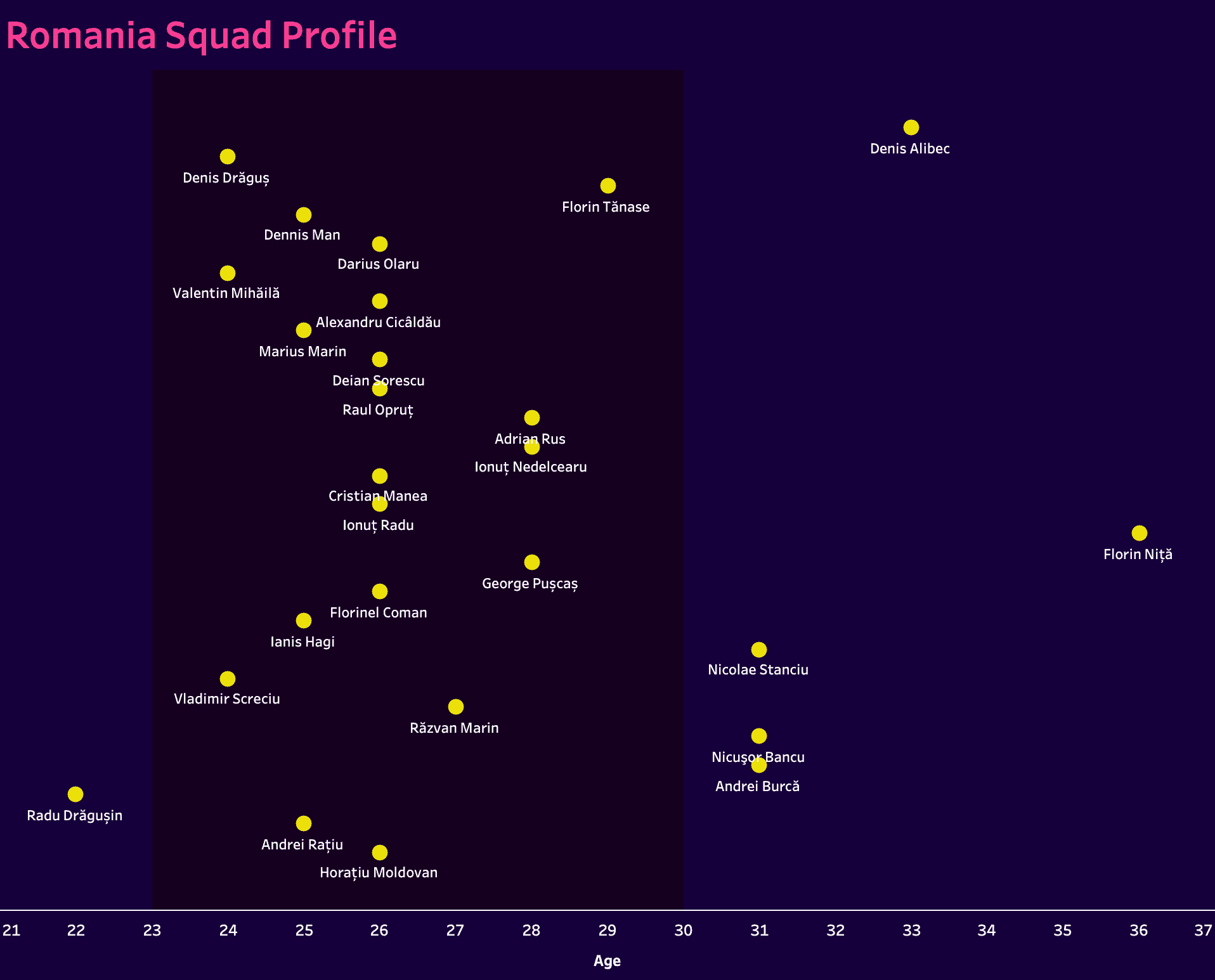
As we can observe in figure 2, the vast majority of what we see as Romania’s best squad falls within the peak age range, making this tournament potentially their best chance of earning the achievement of progressing beyond the group stage for the first time in over two decades, with a plethora of quality players likely in the midst of their best footballing years right now.
Key centre-back Drăgușin is the only Romanian player who lands in the ‘youth player’ category (below 23).
At the same time, we see a small contingent of experienced players making the trip to Germany for this summer’s competition.
Romania Attacking phase
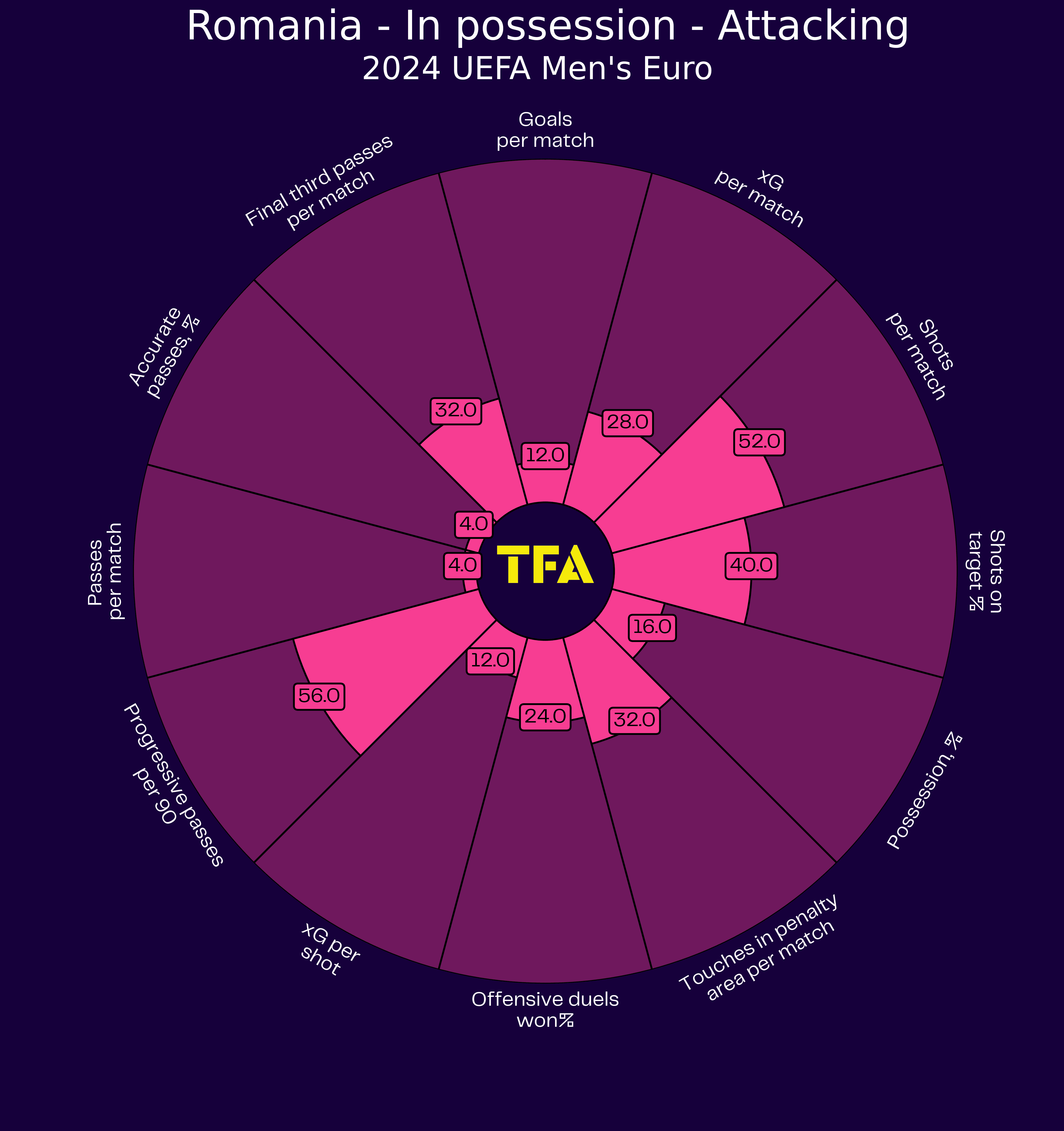
As figure 3 displays, Romania do not enter EURO 2024 as an attacking force to be reckoned with.
With this data taken from games played within all competitions over the past calendar year and compared to that of their EURO 2024 counterparts from the same time period, Romania fail to really stand out in any offensive category.
They fall in the 52nd percentile for shots per match but the 28th percentile for xG per match and 12th percentile for goals per match — probably a result of their tendency to take on low percentage shots from range, which boosts their shot tally but not really their actual goal threat the majority of the time.
Romania will be one of the least possession-based teams at this summer’s European Championships, with Edward Iordănescu likely to set his team up to primarily batten down the hatches at their own end of the pitch and strike on the counter when possible.
Romania tend to play a decent number of long balls forward from the very beginning of their possession play — the goal-kick — encouraging their attackers to gather around in an organised fashion and compete vigorously for the second ball, which they can then carry forward towards the opposition’s goal.
Apart from this, it’s common to see Romania’s goalkeeper and centre-backs trying to get the ball into the feet of a deep central midfielder who can then turn and continue playing the ball forward from a good position to make something happen.
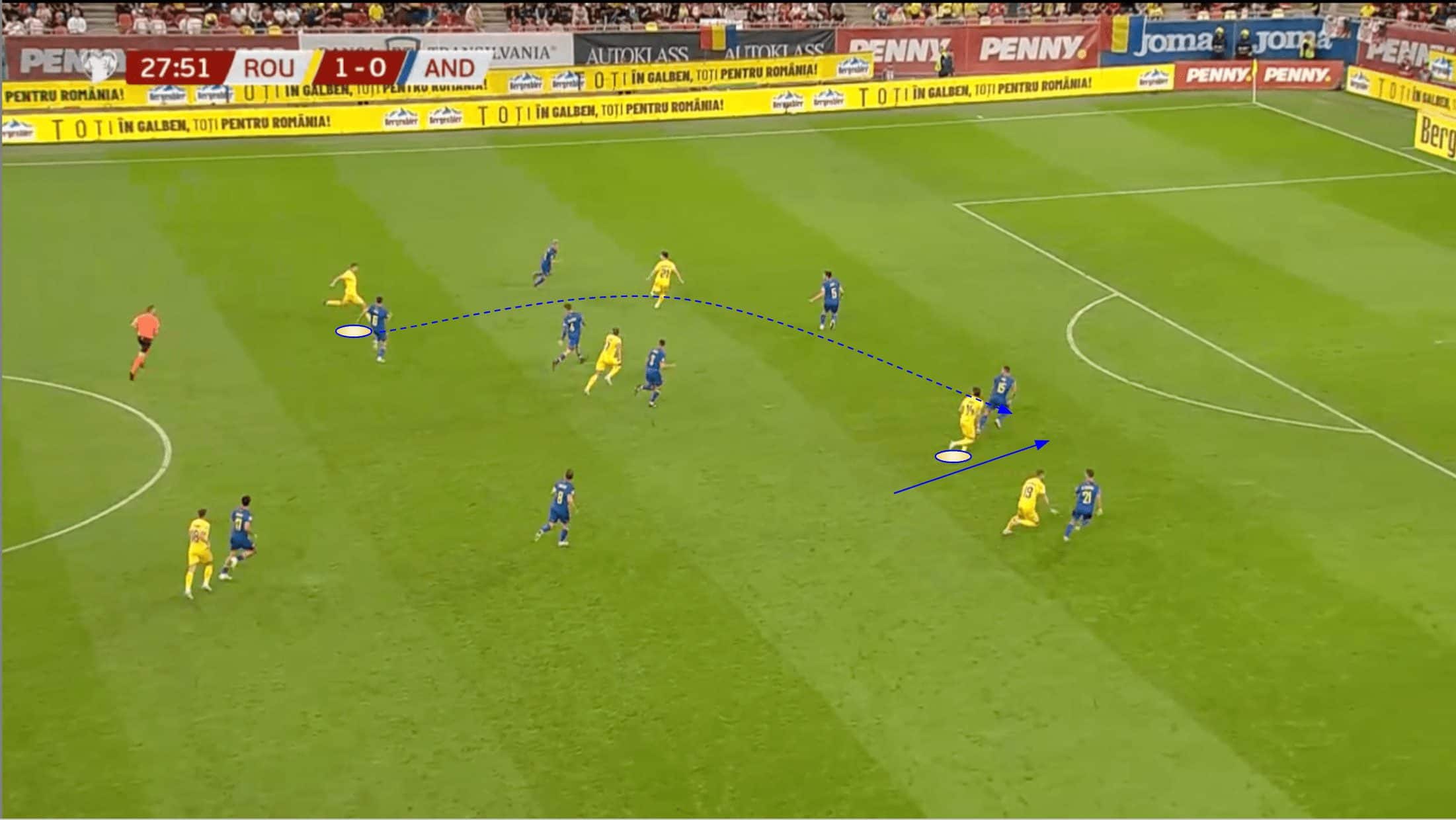
Figure 4 shows an example of an occasion when the ball moved through the centre, giving one of their midfielders a chance to spring an attacker in behind and create a decent opportunity.
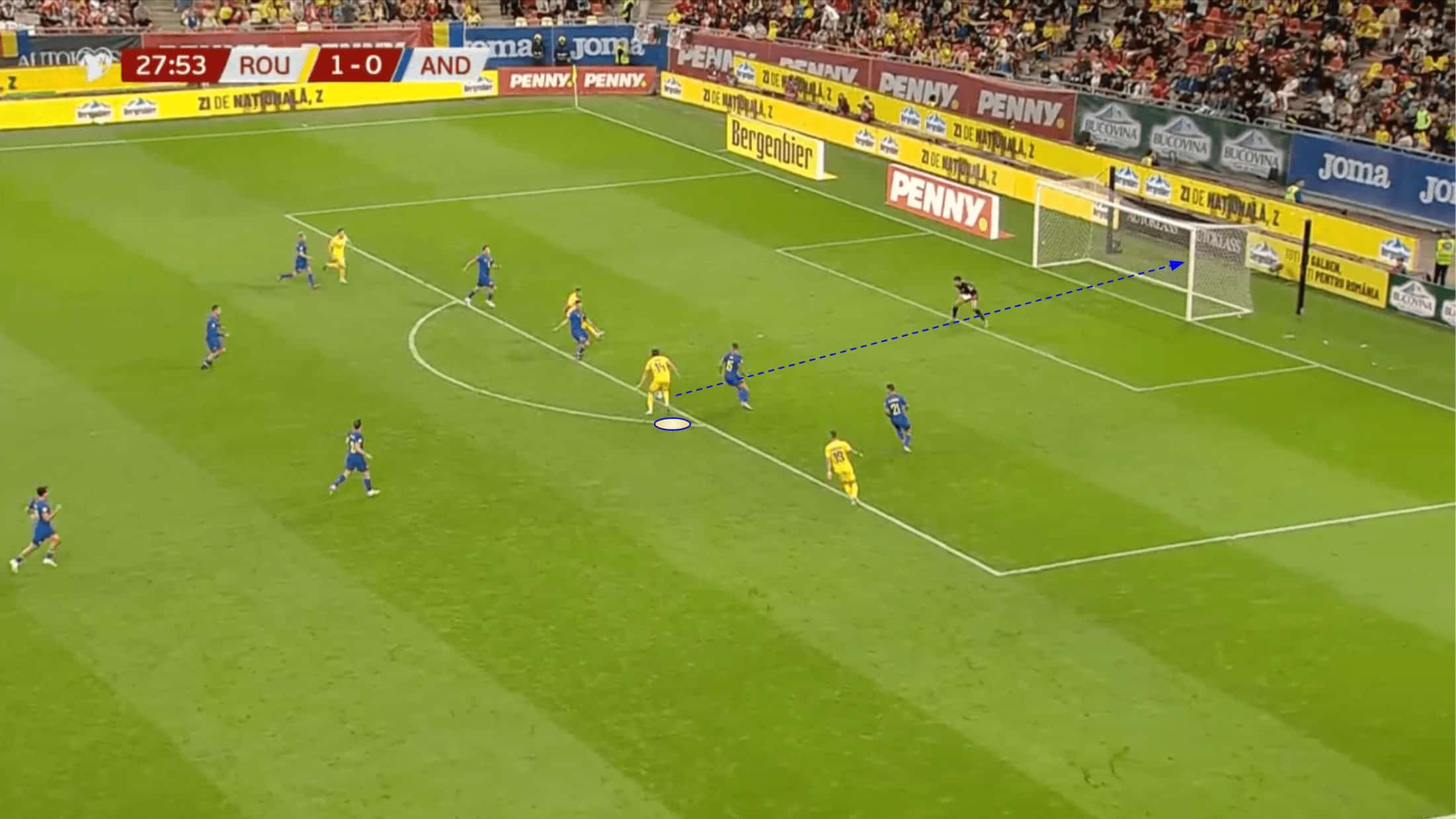
In figure 5, we see the result of the midfielder’s more direct ball to the forward, with Hagi, on this occasion, availing of the opportunity to get a shot off from a decent location.
Still, this opportunity was somewhat snatched at and isn’t a very high percentage chance — Romania do tend to rush the shot at times rather than continuing to work the ball into a really good shooting position.
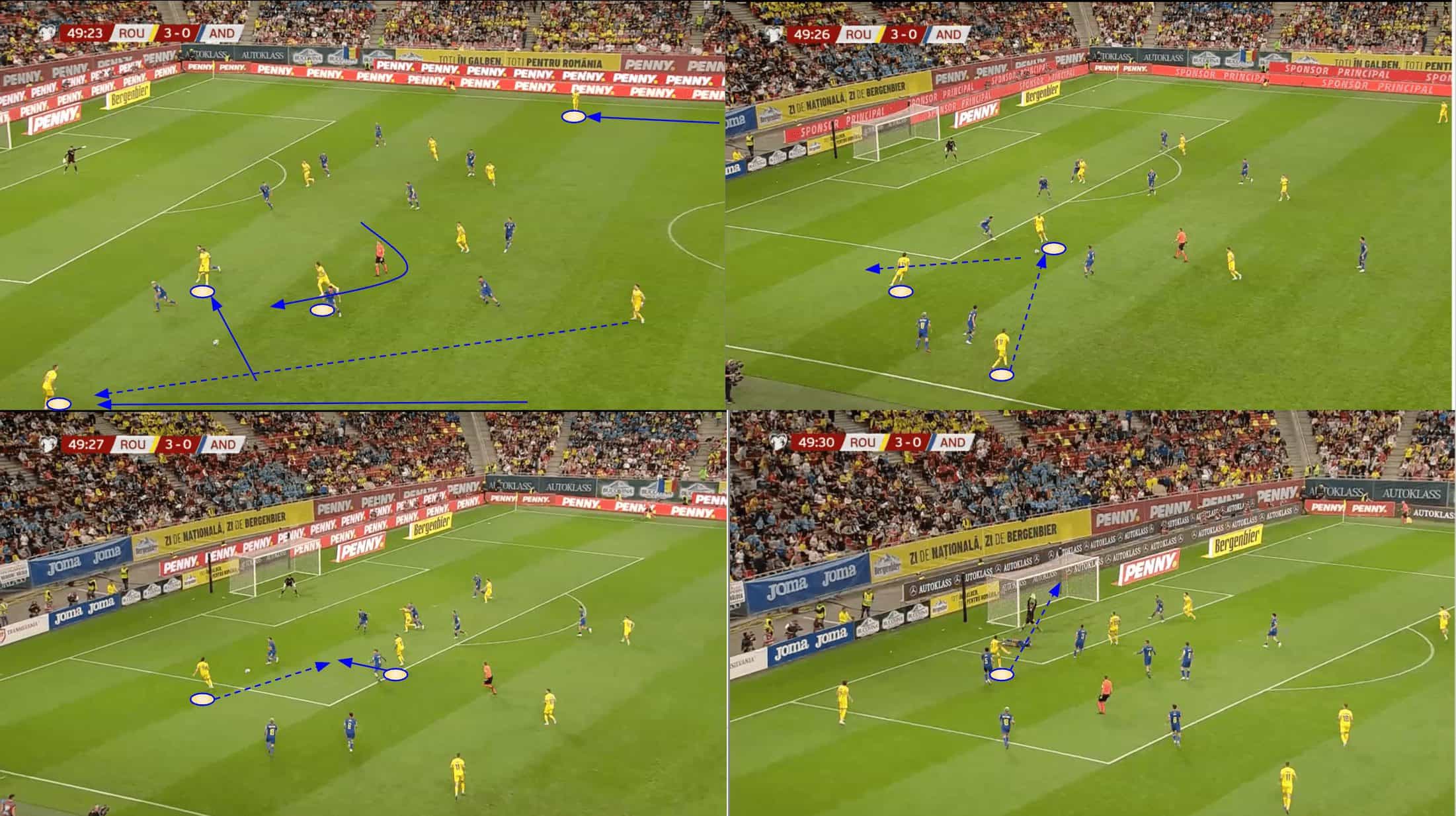
When in the chance creation phase, Romania may look to send their full-backs forward, as we see in the top-left image of figure 6.
As the full-backs get forward, the wingers move inside, and the ‘10’ begins roaming about, trying to find space.
In this case, a quick link-up between the overlapping left-back and the inverted winger catches the opposition’s defence off guard and allows them to play the ball through to the ‘10’, who’s storming the goal in plenty of free space; the attacking midfielder converts and puts Romania one more goal to the good.
We wouldn’t expect to see Romania get too many opportunities to play in this manner at the Euro, with out-of-possession play and transitional attacks likely to be more critical to their overall performance.
However, they do have the potential to catch defences off-guard when they commit the full-back(s) forward and invert the wingers with a roaming ‘10’ as seen above, so it’s worth noting for their opposition and fans alike.
Romania Defensive phase
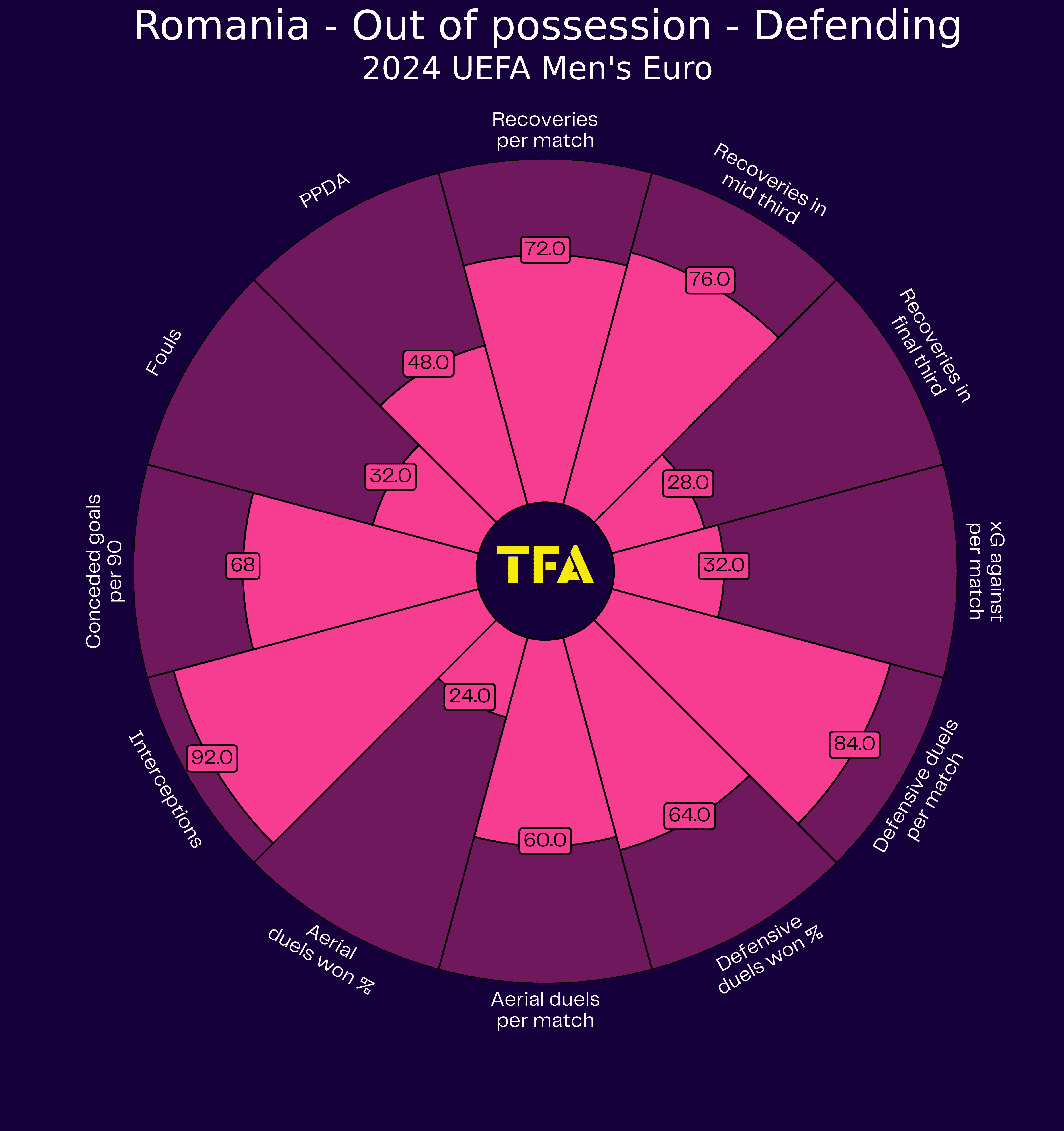
Six teams had a better defensive record than Romania in EURO 2024 qualification; they don’t enter the Euro with the most formidable defence on the continent by any means, but their qualification for this summer’s showcase and highly impressive qualification stage performance was mainly made possible thanks to their solid out-of-possession play which helped them to concede just five goals in 10 games.
As stated previously, Romania will spend the majority of their time without the ball at this summer’s European Championship; they don’t tend to press extremely high or aggressively without the ball, making most of their recoveries in the middle and final third.
Their strong defence is reliant on players performing the roles and following the rules assigned to them by the coaching staff.
Certain patterns are evident in their out-of-possession game, which have proven crucial to keeping a sturdy and difficult-to-break-down structure in defensive phases.
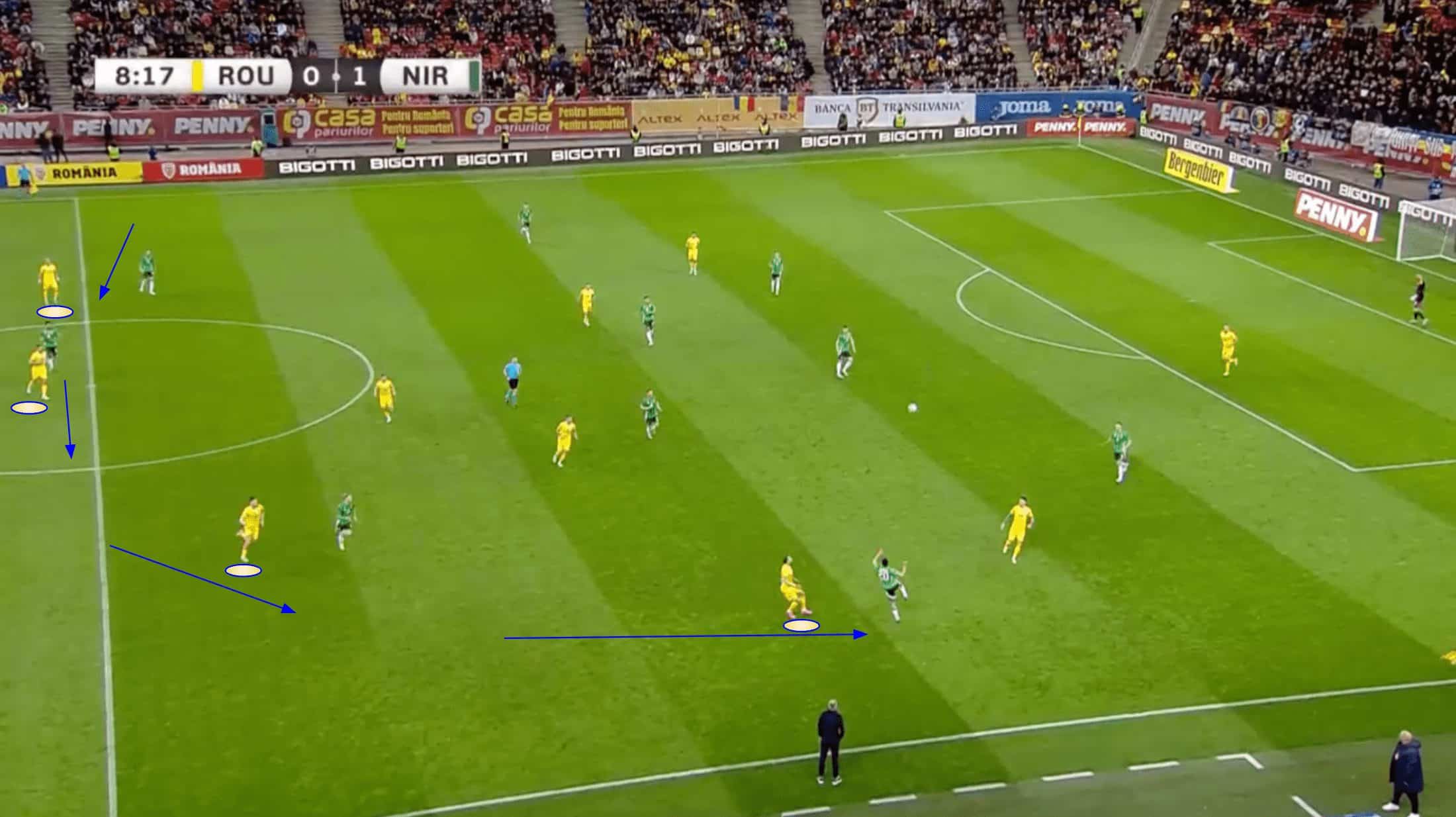
One such pattern is seen in figure 8.
With Romania defending against the opposition’s build-up, the wingers press relatively narrow while the full-backs are to press high up the wing — often going 1v1 with the opposition’s full-back/wing-back.
In order to prevent critical amounts of space from opening up behind that aggressive full-back, the rest of the backline must shift over, as illustrated above.
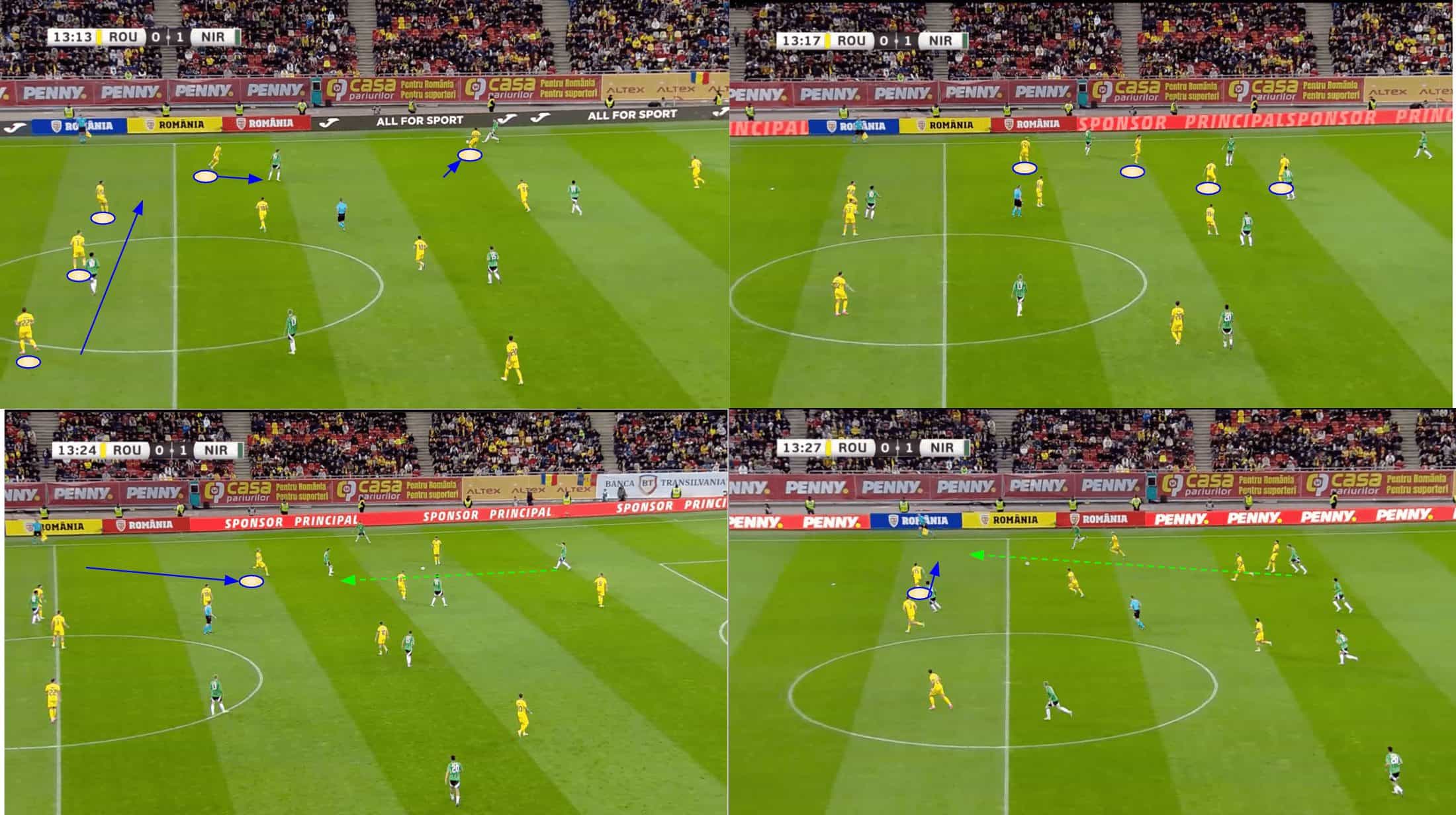
We see another example of this from the same game against Northern Ireland — this time on the left-hand side of the pitch — in figure 9 above.
Initially, the left-back’s pressure is enough to force the opposition backwards, allowing the wingers and midfielders to swarm the recipient of the back pass.
They force Northern Ireland backwards again, but this time, in the bottom-left image, as a winger drops to receive a bit deeper, he creates enough space between himself and the Romanian left-back that he can turn after receiving and play a ball in behind the defender.
This passage of play emphasises the importance of the full-back committing to press quickly, not hesitating, and giving the opponent time to receive, turn, and hurt them with a ball in behind, as there was not enough pressure on them initially.
In this case, the left centre-back does well to slide across and deal with the dangerous ball in behind, once more highlighting this fundamental aspect of Romania’s defensive game.
Their centre-backs must be quick to provide cover in behind and comfortable in defending 1v1 against wide attackers who will be excited to have the opportunity to take them on and try to get away in behind them.
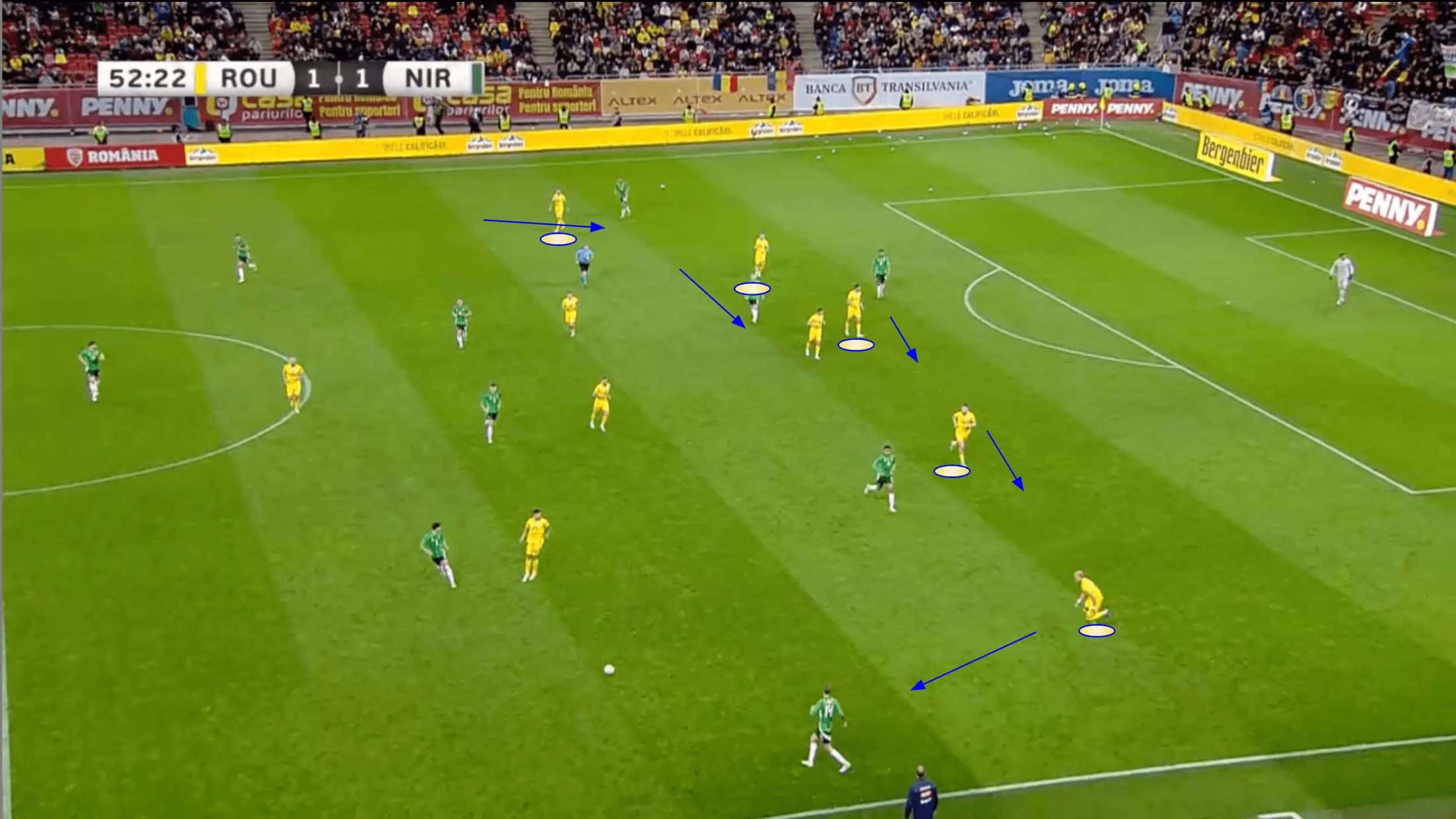
In the low block, it’s common to find at least one of Romania’s wingers dropping deep at times while the back four narrows, forming something of a temporary back-five, as we see in figure 10.
This allows them to provide adequate cover across the full width of the pitch as the opposition sends bodies forward.
All of Romania’s players will be contributing to some extent without the ball, with even the centre-forward coming back to help apply pressure on the opposition’s midfielders, which could hurt them in the chance creation phase while Tricolorii defend deep.
Romania Transitions
Attacking transitions will be a critical offensive outlet for Romania if they’re to achieve their goal of progressing at least beyond the group.
They will primarily be relying on their ability to make the most of attacking moments, carefully picking their chances to get forward, as opposed to sustaining attacks for lengthy periods.
Goalkeeper Moldovan will look to distribute the ball quickly to full-backs and wingers when he gathers possession from an opposition attack.
After their attack peters out, these areas are often left with the least coverage by the opponent, giving their wide creators like Hagi and Coman a good opportunity to shine on the counter.
Furthermore, Romania’s centre-forward and wingers will look to get up the pitch fast when Moldovan regains possession in their box, and the goalkeeper will try to find them with a long ball forward, giving his attackers a chance to win the second ball resulting from the direct pass forward.
Thus, Romania will create a decent attacking opportunity against the opposition’s weakened backline in transition.
These methods of direct attack are commonplace within Iordănescu’s Romania.
Opponents must be wary of them —they proved very helpful for Tricolorii in their successful EURO qualification campaign.
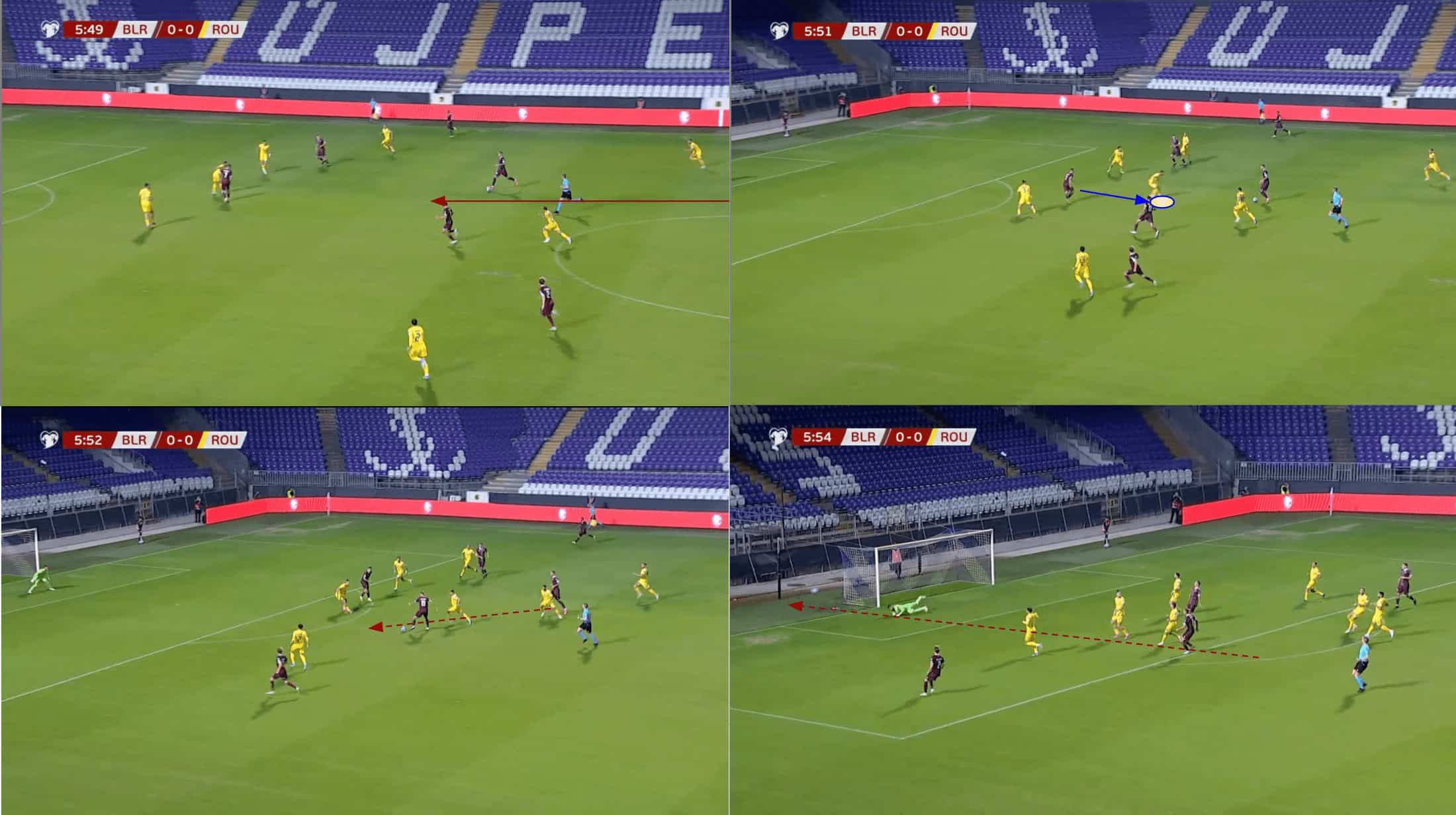
Moldovan will also try to distribute the ball centrally at times, either in transition or from build-up, when a holding midfielder like Screciu or Marin finds space.
In such situations, Romania will aim to drive the ball forward quickly via the valuable space afforded to them in the middle of the park.
On occasion, this can backfire as the opponent manages to increase the pressure on the central receiver and either disposes of them or forces them into a poor pass—thus leading to a turnover and transition for Iordănescu’s side to have to try to guard against.
We see an example of how they tried to deal with this in figure 11, with an opponent driving forward through the centre against Romania’s backline after having just regained the ball in midfield.
A centre-back steps out, but the opposition can play around them, ultimately getting a shot off from a less-than-ideal location and failing to fully take advantage of this opportunity as they send the final shot wide of the post.
Romania will have to be careful to limit the amount of opportunities like this one that they concede during the Euros this summer, as the quality of the opponent they’ll be facing in Germany will not squander too many opportunities to counter from the middle of the park like this one!
Still, the organisation, technical quality, and recovery pace in Tricolorii’s backline will be vital in transitional defence, just as we showed it is in settled defensive phases.
The excellent defensive work rate usually exhibited by all players taking to the pitch for Iordănescu’s team of late will also help limit the amount of time and space the opposition enjoys during transitional attacks.
Romania Defenders
We’ve got Rațiu starting at right-back for Romania in our team, but we expect decent competition from Cristian Manea and the versatile right-sided wide player Deian Sorescu, both of whom we also tip to make the trip to Germany for Romania this summer.
Meanwhile, on the left side of defence, Bancu has been a reliable starter for Iordănescu of late, but we believe the 45-year-old coach will also bring some backup on this side of defence, potentially in the form of 26-year-old Raul Opruț.
Defensive organisation and quality may make or break Romania’s performance in this tournament, and we’d expect plenty of options to be taken to the tournament to cover for emergencies.
Radu Drăgușin and Andrei Burcă represent two fine central defensive options who will likely start for Romania in the Euros.
Still, we also expect to see Adrian Rus and Ionuț Nedelcearu make their way to the tournament and offer cover and/or competition for that centre-back duo.
Romania Midfielders
We’ve got internationally experienced Răzvan Marin and captain Nicolae Stanciu playing alongside the less tenured Vladimir Screciu in our midfield three — though we’d also expect to see Marius Marin, Alexandru Cicâldău, Valentin Mihăilă and Darius Olaru feature at some point to varying degrees during the competition, depending on precisely what Iordănescu is looking for at that particular moment in the contest.
Romania have decent quality and a lot of experience in the middle of the park; they’ll be hoping for some reliable performances from those positioned there to avoid giving away too many of the dangerous transitional attacks we discussed previously!
Romania Forwards
Hagi, Coman and Pușcaș make up our Romania front three, but we’re almost certain to see a decent amount of rotation in the centre-forward position, with Denis Alibec having been deployed almost as much as Pușcaș in more recent games.
Denis Drăguș, Florin Tănase and Dennis Man all offer offensive versatility in terms of position and role, which will be incredibly useful for Romania’s coaching staff from a tactical perspective should they find themselves seeking something different during games without sacrificing quality.
Romania Key Player
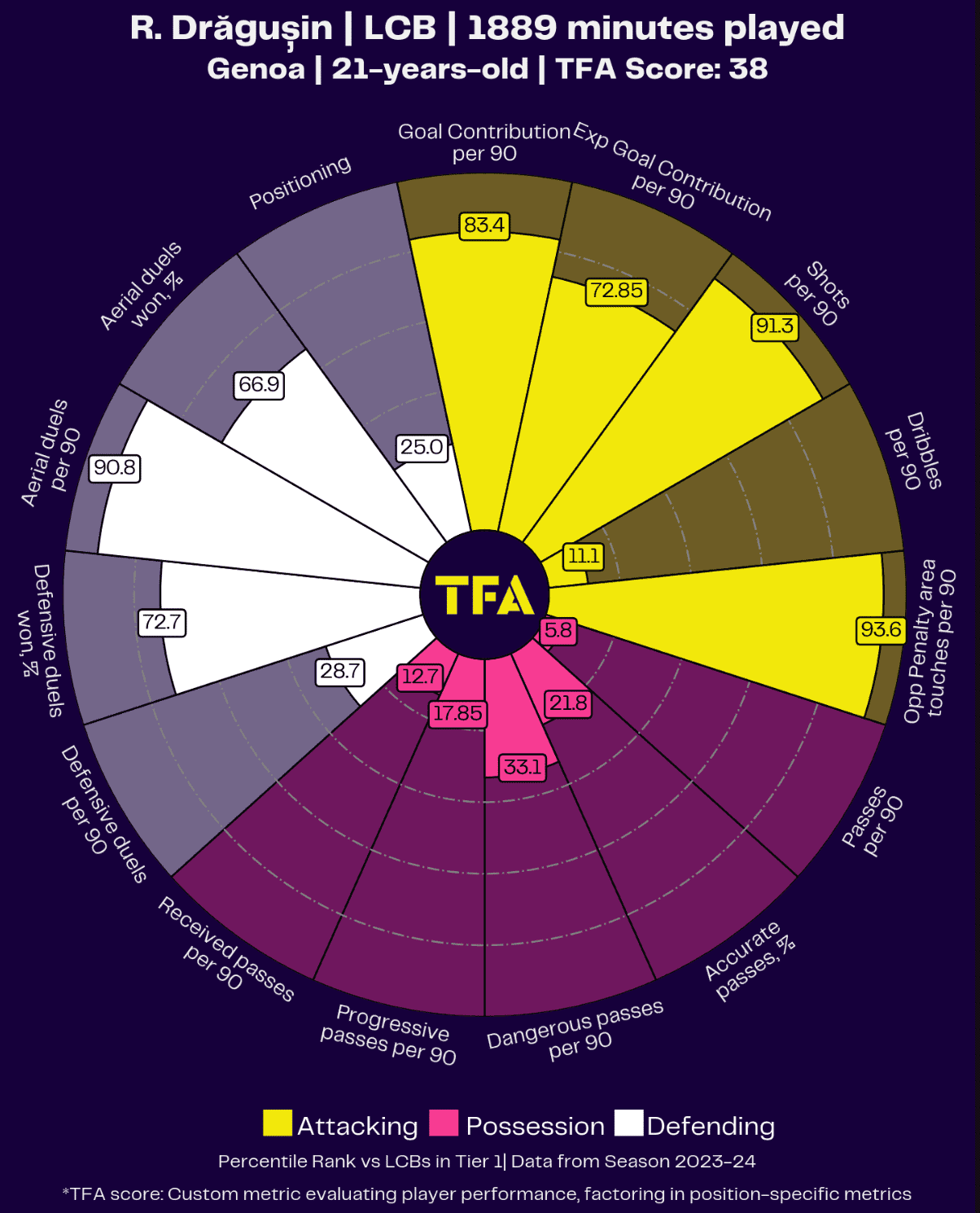
We’ve already spoken at length about why Romania’s defence is going to be vital to their success this term, and we’ve opted for Tottenham Hotspur centre-back Radu Drăgușin — the youngest player we’ve included in our predicted squad — as the man to highlight as Tricolorii’s key player during the Euros.
Joining Spurs in January, the 22-year-old centre-back accumulated just 424 minutes in the Premier League this term compared with 1889 in Serie A with Genoa, where he’d been playing previously.
Hence, our data on his 2023/24 campaign comes from his time in Italy’s top-flight instead.
From the above pizza chart, we can see that Drăgușin is not a high-volume defender in terms of actions, with a relatively low percentile rank in defensive duels per 90 and positioning.
However, his success rate, both in ground defensive duels and aerial duels, is impressive, and this reliability is what Iordănescu will be counting on from the young central defender in his backline.
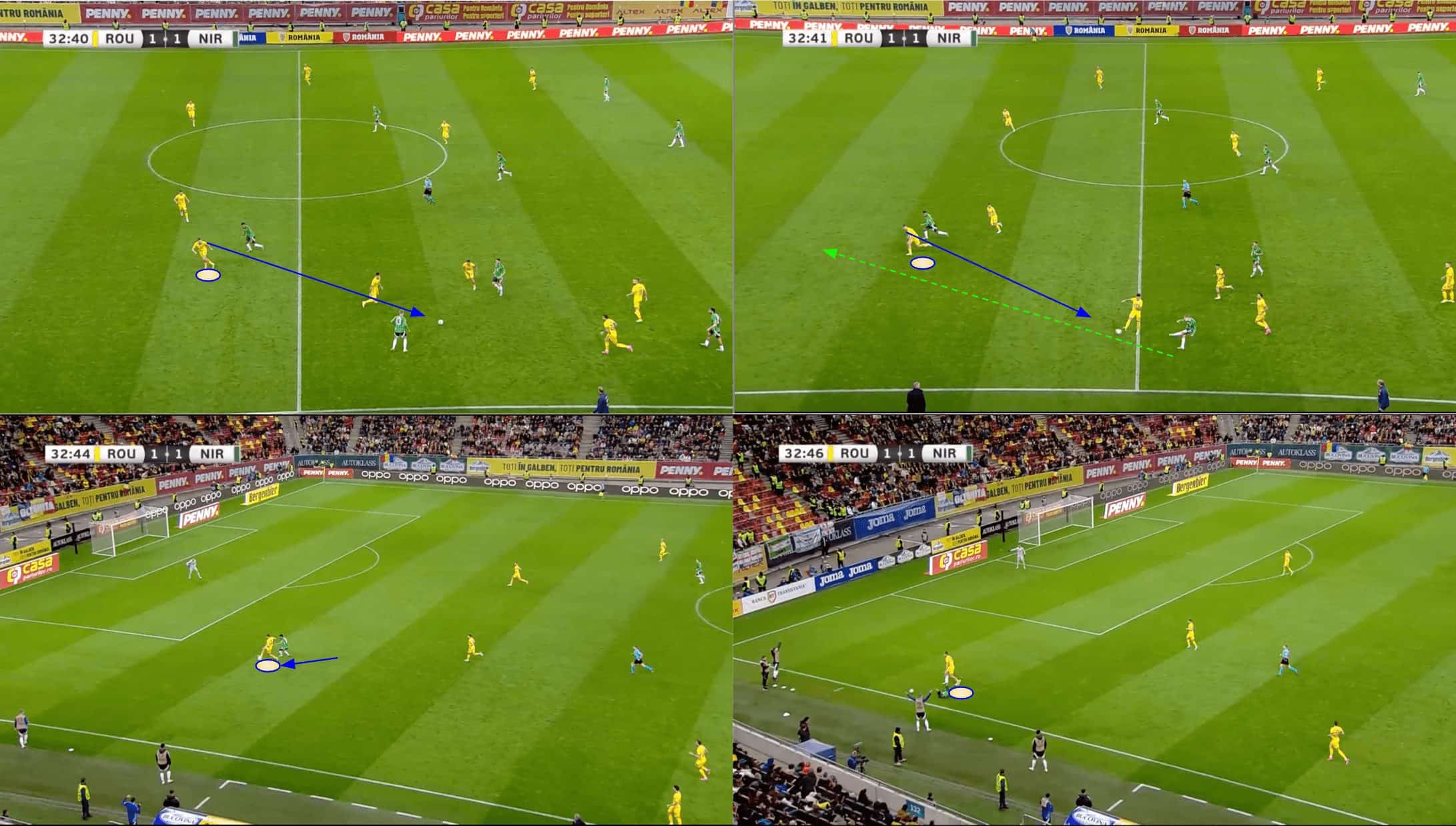
Drăgușin reads the game exceptionally well for a young centre-back.
This quality, combined with his pace and technical defensive ability, makes him a lifesaver for Tricolorii at times.
We see an example of this in Figure 13, where he immediately spots the danger of the wide man receiving while the nearer attacker begins moving in behind him.
Thus, he positions his body well in a side-on orientation, times his run well, and gets back in time to deal with the dangerous ball in behind.
He also completely outmuscles this attacker, attempting to duel with him in the end before seeing the ball out of danger, to highlight one instance of some of his most impressive defensive qualities on show.
Romania Tournament prediction
Romania are coming off the back of an excellent qualification campaign and should be full of confidence in EURO 2024.
Belgium should realistically top Group E, which features Romania, but second place is very much up for grabs and should be a hard-fought battle between the remaining three teams.
Romania and Ukraine are probably the more likely two contenders for that spot.
Ukraine may have a slight edge in terms of quality, but Romania’s defence is not to be underestimated; if things come together well in the tournament, they can at least get second, but third place may be the more realistic prediction if we were pushed for a clear answer right now.

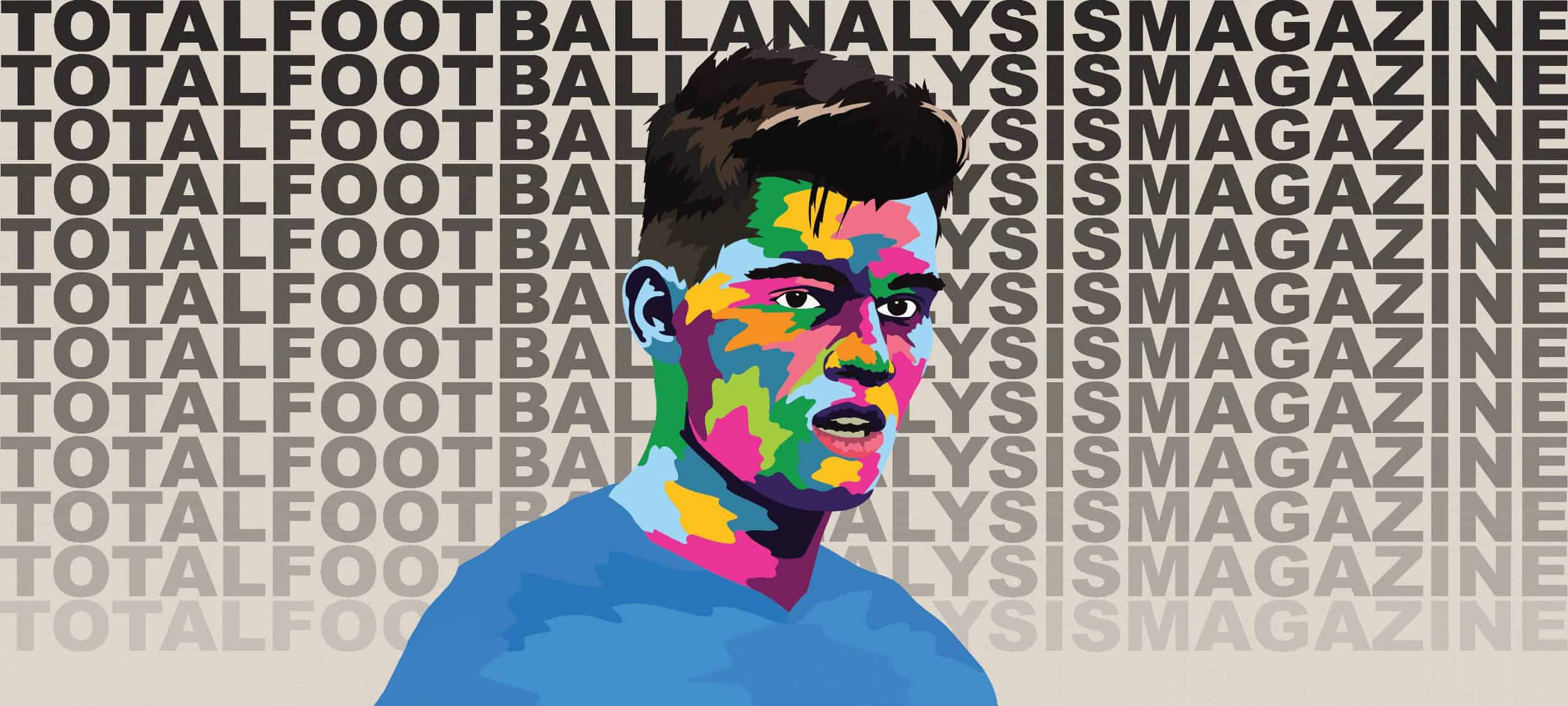



Comments